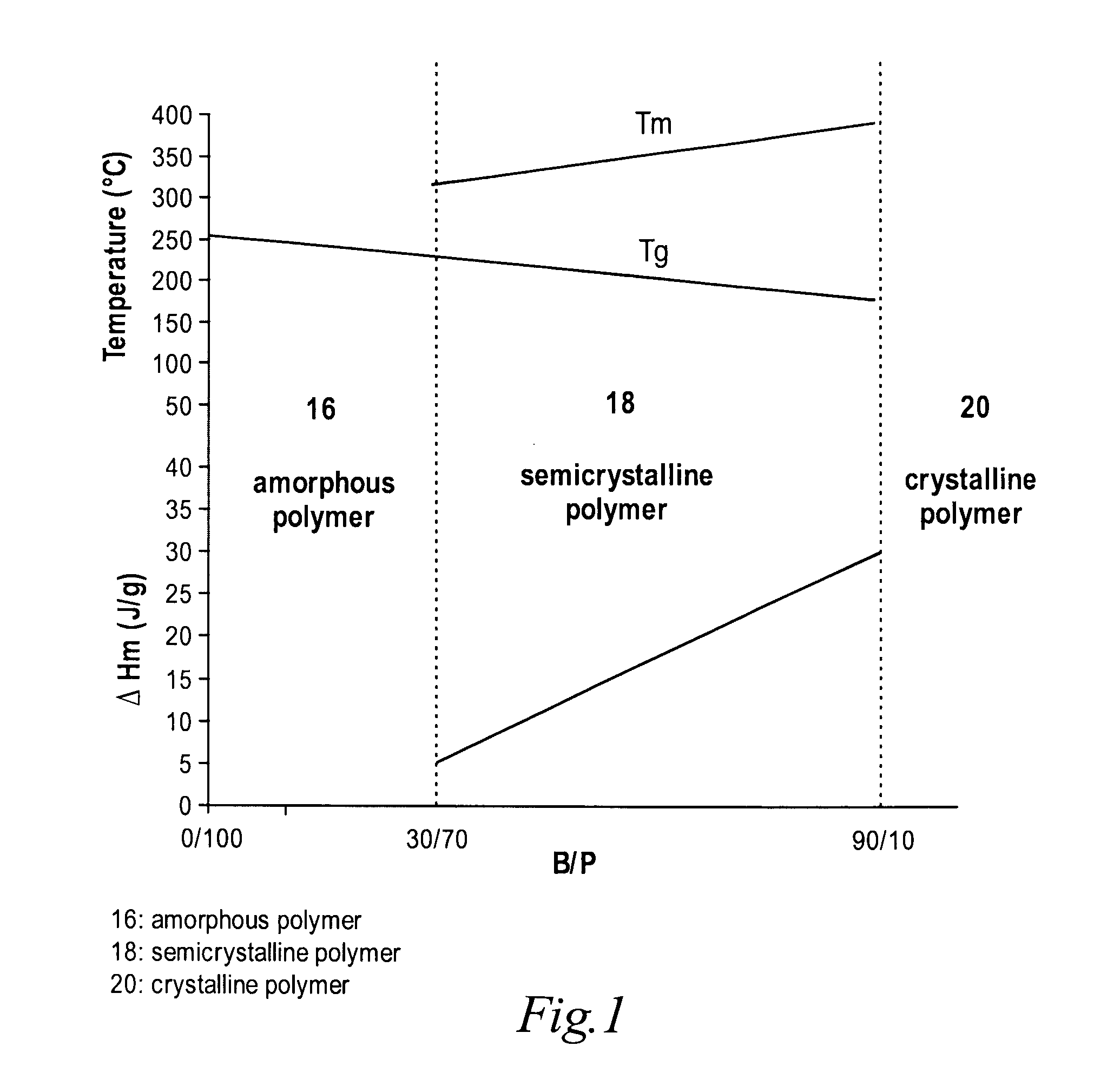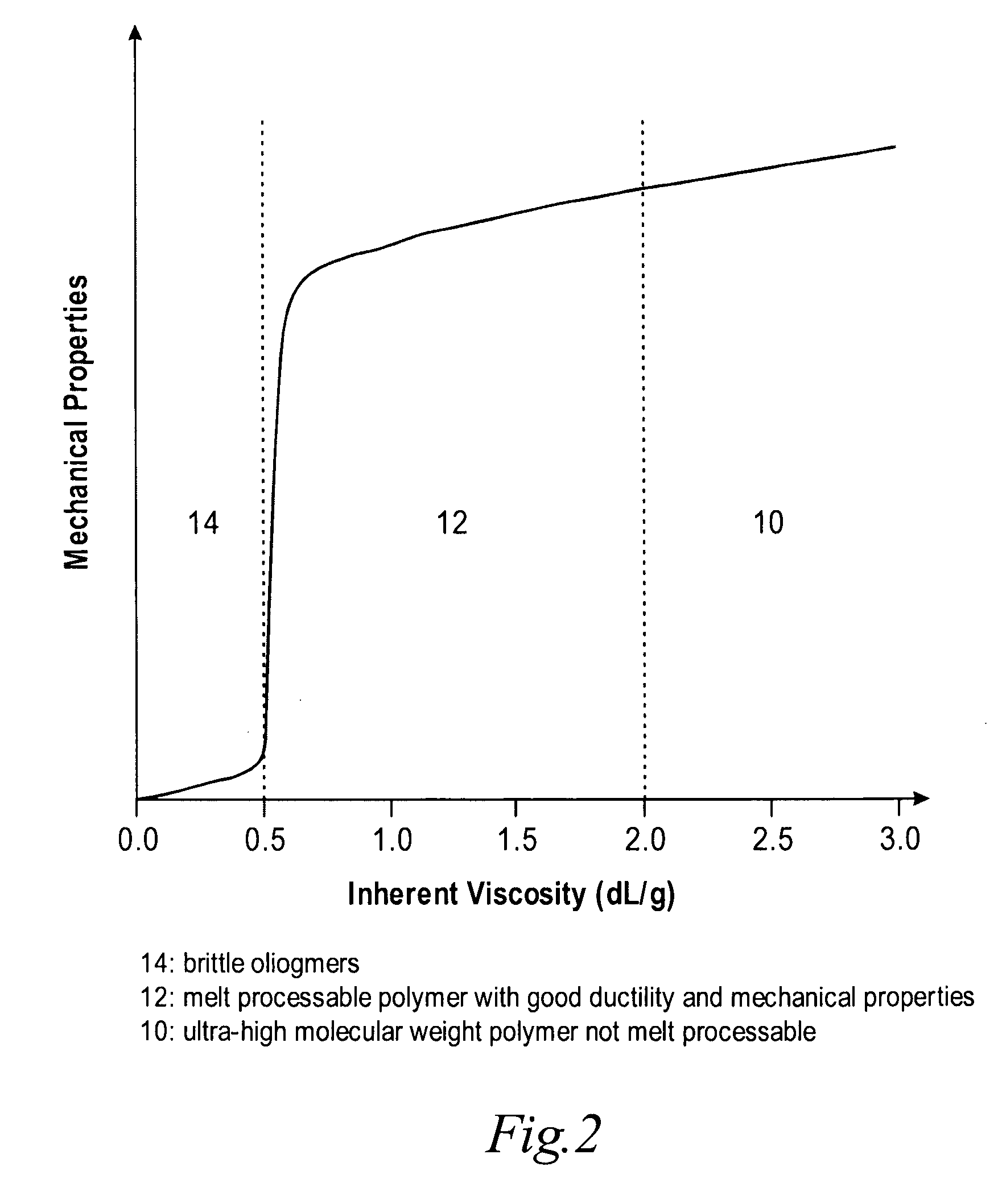High temperature melt processable semi-crystalline poly (aryl ether ketone) containing a (4-hydroxyphenyl) phthalazin-1 (2H)-one comonomer unit
a technology of aryl ether ketone and comonomer unit, which is applied in the field of semi-crystalline poly (aryl ether ketone) polymers, can solve the problems of not being suitable for use in many industrial or commercial applications, poor resistance to organic solvents and liquids, and all currently known polymers of this type have significant commercial disadvantages, etc., to achieve improved chemical resistance, high molecular weight, and enhanced thermal resistance
- Summary
- Abstract
- Description
- Claims
- Application Information
AI Technical Summary
Benefits of technology
Problems solved by technology
Method used
Image
Examples
example 1
Copolymer with Molar Ratio of 4,4′-Biphenol and Phthalazinone B / P=30 / 70
[0076]To a 250 mL three-neck round-bottomed flask, equipped with a nitrogen inlet, thermocouple, mechanical stirrer, Dean-Stark trap and condenser, 21.82 grams (100.0 mmol) of dried 4,4′-difluorobenzophenone, 16.76 grams (70.0 mmol) of dried phthalazinone monomer, 5.59 grams (30.0 mmol) of dried 4,4′-biphenol and 14.65 grams (106.0 mmol) of anhydrous potassium carbonate were charged. Diphenyl sulfone (132.5 grams) and chlorobenzene (30.0 ml) were then added. The reaction medium was heated to 170° C., and chlorobenzene was distilled to remove water over one hour. The reaction mixture was then heated to 200° C. and maintained for two hrs. The reaction mixture was further heated to 300° C. and maintained for four hrs. The reaction was terminated, and the mixture was cast into sheet on a glass surface in a glass tray and cooled to room temperature. The cooled solid was then hammer milled to fine particles less than a...
example 2
Copolymer with Molar Ratio of 4,4′-Biphenol and Phthalazinone B / P=40 / 60
[0080]A copolymer with a 40 / 60 molar ratio of 4,4′-biphenol and phthalazinone monomer was prepared according to the procedure described in Example 1. The resulting polymer has an inherent viscosity (IV) of about 0.74 dL / g, a glass transition temperature of about 225° C., a melting temperature of about 336° C. and a melting endotherm of about 8.0 J / g. The polymer is insoluble in chloroform, dimethylformamide (DMF) and N-cyclohexylpyrrolidinone (CHP).
example 3
Copolymer with Molar Ratio of 4,4′-Biphenol and Phthalazinone B / P=60 / 40
[0081]A copolymer with a 60 / 40 molar ratio of 4,4′-biphenol and phthalazinone monomer was prepared according to the procedure described in Example 1. The resulting polymer has an inherent viscosity (IV) of about 0.79 dL / g, a glass transition temperature of about 204° C., melting temperature of about 357° C. and a melting endotherm of about 16.0 J / g. The polymer is insoluble in chloroform, dimethylformamide (DMF) and N-cyclohexylpyrrolidinone (CHP).
PUM
| Property | Measurement | Unit |
|---|---|---|
| Temperature | aaaaa | aaaaa |
| Temperature | aaaaa | aaaaa |
| Temperature | aaaaa | aaaaa |
Abstract
Description
Claims
Application Information
 Login to View More
Login to View More - R&D
- Intellectual Property
- Life Sciences
- Materials
- Tech Scout
- Unparalleled Data Quality
- Higher Quality Content
- 60% Fewer Hallucinations
Browse by: Latest US Patents, China's latest patents, Technical Efficacy Thesaurus, Application Domain, Technology Topic, Popular Technical Reports.
© 2025 PatSnap. All rights reserved.Legal|Privacy policy|Modern Slavery Act Transparency Statement|Sitemap|About US| Contact US: help@patsnap.com



